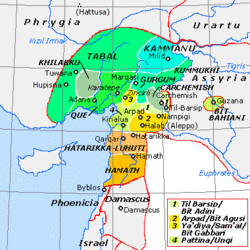Kummuh
| Kummuh | ||||||||||
| Kummaḫa | ||||||||||
|
||||||||||
|
Kummuh among the Neo-Hittite states
|
||||||||||
| Capital | Kummuh | |||||||||
| Languages | Hieroglyphic Luwian | |||||||||
| Religion | Luwian religion | |||||||||
| Government | Monarchy | |||||||||
| Historical era | Iron Age | |||||||||
| • | Established | Unknown | ||||||||
| • | Disestablished | 708 BC | ||||||||
|
||||||||||
| Today part of |
|
|||||||||
Kummuh was an Iron Age Neo-Hittite kingdom located on the west bank of the Upper Euphrates within the eastern loop of the river between Melid and Carchemish. Assyrian sources refer to both the land and its capital city by the same name. The city is identified with the classical-period Samosata (modern-day Samsat Höyük), which has now been flooded under the waters of a newly built dam. Urartian sources refer to it as Qumaha. The name is also attested in at least one local royal inscription dating to the 8th century BCE. Other places that are mentioned in historical sources as lying within Kummuh are lands of Kištan and Halpi, and cities of Wita, Halpa, Parala, Sukiti and Sarita(?). Kummuh bordered the kingdoms of Melid to the north, Gurgum to the west and Carchemish to the south, while to the east it faced Assyria and later Urartu.
Several indigenous rock inscriptions have been found in the region, all written in hieroglyphic Luwian, attesting to the continuity of Hittite traditions. In his annals, the Assyrian king Sargon II referred to the Kummuh ruler as 'Hittite', and several rulers of Kummuh bore the same names as famous Hittite kings of the 2nd millennium BCE: Hattušili(?), Šuppiluliuma, and Muwattalli (in Assyrian sources Qatazilu, Ušpilulume, and Muttallu, respectively).
From the Middle Hittite Period (15th century BCE) onwards, the Hittite archives of Hattuša refer to a city of Kummaha, which might be identical to the later city of Kummuh.
Most of the information about Kummuh comes from Assyrian sources. In a fragmentary context attributed to the Assyrian king Tukulti-Ninurta I (13th century BCE), the land of Kummuhi is mentioned as bordering the land of Mt. Kassiyari. Afterwards, nothing is known until the 9th century BCE. From the beginning of the 9th to the middle of the 8th centuries, Kummuh seems to have remained a peaceful tributary state allied with Assyria. In 866 BCE, Kummuh king Qatazilu paid tribute to Assyrian king Ashurnasirpal II in the city of Huzirina (modern-day Sultantepe). In 858 BCE, Assyrian king Shalmaneser III reported in his Kurkh Monolith that Qatazilu submitted to him peacefully after the Assyrian king crossed Euprates on a campaign to the west. A similar report is mentioned for another campaign in 857. In 853 BCE, a new king in Kummuh, Kundašpi, was reported by Shalmaneser III as being among the northern Syrian kings who submitted to him in the city of Pitru.
...
Wikipedia

